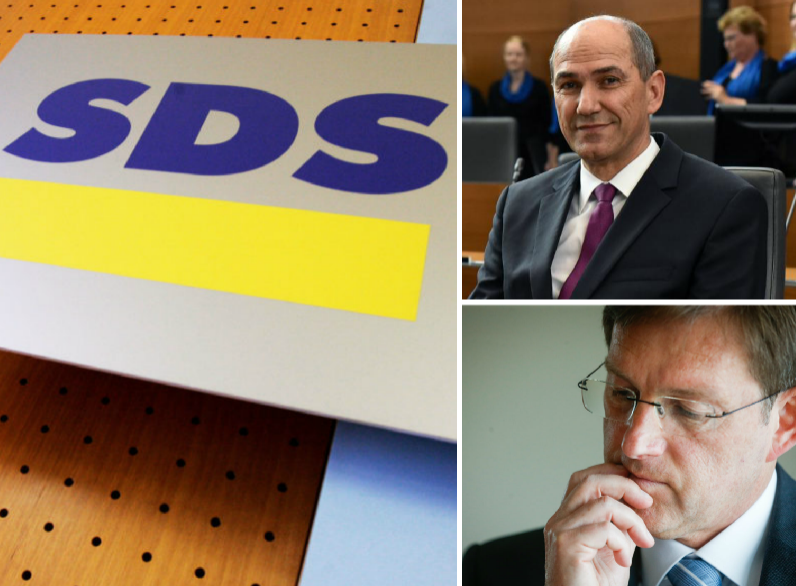If the election was held this year, Janša’s Slovenian Democratic Party (SDS) would win convincingly, as it has maintained a support of more than 25% for 6 months in a row. Židan’s Social Democrats (SD) and Ljudmila Novak’s New Slovenia (NSi) are trailing relatively far behind, while the support for Cerar’s ruling Modern Centre Party (SMC) has dropped sharply. The coalition government of SMC, DeSUS, and SD is supported only by about a third of Slovenian citizens, and significantly more than half of the nation is convinced that Cerar’s government has not met expectations.
The biggest opposition party SDS maintains a relatively high level of support (27.2% in July; 25.6% in August) and therefore has a considerable lead over the other parties. SD has retained 2nd place, but its support fell by 3.1 percentage points (19.5% in July; 16.4% in August). 3rd place has been taken by NSi, which has increased its support by 5.5 percentage points (6% in July, 11.5% in August). SMC is in 4th place, its support having fallen by 8.1 percentage points (17.9% in July; 9.8% in August). The balance of power among the leading parties has therefore changed somewhat, since SMC has been pushed out of the top three by NSi.
The average age of the respondents is 50.1 year, and they come from all over Slovenia – most of them, about a fifth, come from the Central Slovenia region. The majority of the respondents, 39.8%, are part of the oldest age group (55 years or more), 37.5% are part of the middle age group (35–54 years), and 22.7% are part of the youngest age group (18–34 years). A majority of the respondents have a secondary education (31.2%), followed by those with a complete or incomplete primary education (25.1%). 28% of the respondents have a vocational education, and 15.7% have a higher education.
The survey was carried out in the period from 9 August to 11 August 2017 with a sample of 725 respondents (50.9% of which were women), and it was conducted by the company for market research and opinion polling Parsifal SC. It was a telephone survey, and the sampling frame encompassed the telephone directory (80% the mobile network and 20% the fixed network). The survey measured the support for the current Slovenian Government and the balance of power between the political parties.
Do you support the current government?
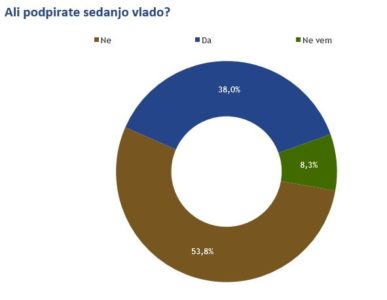
Large majority still dissatisfied with Cerar’s government
For more than half of the respondents (53.8%), Miro Cerar’s government has not met expectations, while 38% of voters believe that expectations have been fulfilled, and 8.3% of voters remain undecided.
Young people (18–34 years) are the most dissatisfied with the work of the SMC–DeSUS–SD coalition (55.2%), while the oldest age group (55 years or more) is the most supportive of the government (40.9%). As far as education is concerned, it is those with a higher education that are the most disappointed (58%) with the Cerar–Erjavec–Židan coalition, while those with a secondary education are the most supportive (40.9%).
Fluctuations in support for government over time
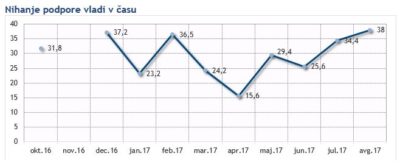
A large majority is still dissatisfied with the work of the SMC, DeSUS, and SD coalition
The support for Cerar’s government has increased by 3.6 percentage points in the last month (34.4% in July; 38% in August), but at the same time, well over half of Slovenian citizens (53.8%) remain dissatisfied with the work of the government. The graph of fluctuations in the support for the Slovenian Government shows that support has been rising in the last few months, but it is still low, and as a rule, it remains between one fourth and one third.

Which party would you vote into the National Assembly of Slovenia if the election were held this Sunday?
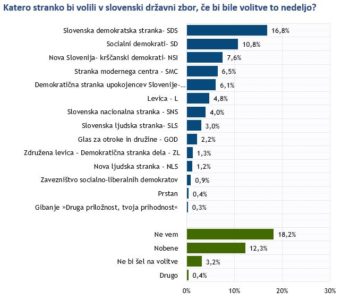
SDS remains on top, SMC outside top three
If an early election were held this year, most Slovenian citizens would vote for SDS (16.8%), followed by SD (10.8%) and NSi (7.6%), while the ruling SMC has dropped to 4th place (6.5%). A large number of the respondents are still uncommitted, most of them being undecided (18.2%), while 12.3% of respondents would not vote for any party. 3.2% would not go vote. 0.7% of the respondents would vote for a potential new party or a party that is not listed in the survey.
Janša’s SDS most popular in all age groups
Janša’s SDS enjoys its greatest support among young people (18–34 years) with 20.9%, while Židan’s SD (11.8%) and Ljudmila Novak’s NSi (10.8%) are most strongly supported by people in the oldest age group (55 years and more), though SDS still attracts the most support in this age group as well (18.8%), i.e. 7 percentage points higher than SD and 8 percentage points higher than NSi. As far as age groups are concerned, the Slovenian Democratic Party receives the most support in all categories.
Only committed voters
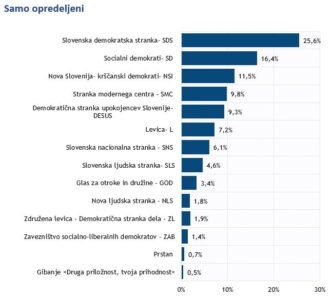
1. SDS, 2. SD, 3. NSi
Among committed voters, the balance of power is as follows: the Slovenian Democratic Party – SDS is in first place (25.6%), the Social Democrats – SD are second (16.4%), and third place has been taken by New Slovenia – Christian Democrats – NSi (11.5%). Cerar’s SMC has dropped to 4th place and would receive 9.8% of the votes. Other existing parliamentary parties that would again enter the “house of democracy” are Erjavec’s DeSUS (9.3%) and Mesec’s Left (7.2%). The parties returning to the Slovenian Parliament would be Jelinčič’s Slovenian National Party – SNS (6.1%) and Zidanšek’s Slovenian People’s Party – SLS (4.6%).
Primč’s Voice for Children and Families – GOD (3.4%) would miss out on a place in the National Assembly of Slovenia by a hair’s breadth, and Kangler’s New People’s Party – NLS (1.8%) would miss out by a little more. They are followed by the United Left – Democratic Labour Party (1.9%), the liberal party Prstan (0.7%), and the movement “Druga priložnost, tvoja prihodnost” (Second Chance, Your Future) (0.5%). The failed Alliance of Alenka Bratušek (1.4%) would drop out of the National Assembly.
Fluctuations in support for parties over time
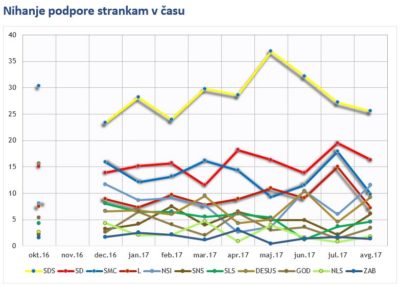
SDS with support of over 25% for half a year, followed by SD, NSi, and SMC
The Slovenian Democratic Party has maintained a great popularity for the last 6 months. Its support has steadily remained at around 30%, i.e. continuously above 25% (27.2% in July; 25.6% in August), which means it has significantly more support than other parties on the Slovenian political scene. The support for second-placed SD has fallen by 3.1 percentage points (19.5% in July; 16.4% in August). NSi, which has taken third place, has increased its support by 5.5 percentage points (6% in July, 11.5% in August). SMC, whose support has fallen by 8.1 percentage points (17.9% in July; 9.8% in August), is in 4th place.
Jure Ferjan

